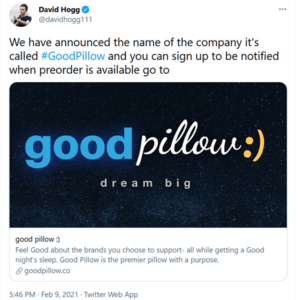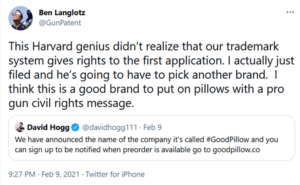By Ben Langlotz
|
April 5, 2021
|
Firearms
|
0 Comments
PILLOW FIGHT!
How I Taught a Harvard Boy A Lesson About Trademarks
It was a Tuesday night.
I was surfing Twitter one evening in February when I ran across a story about David Hogg’s new scheme. He’s the Parkland High School student who turned anti-gun activist after his school was attacked and many of his classmates murdered. Doubts have been raised about his truthfulness about his presence and exploitation of the evil act and its tragic result, and I don’t have anything to add to the accusations that he Hogged the limelight for personal gain. It did work out well, because with an academic record and SAT scores that are below standards and got him rejected by several “Cal State” schools, he received admission to Harvard following his surge to national prominence.
Hogg has gone beyond the gun issue and became a liberal activist, happy to share his liberal perspective on many national issues, especially anything against President Trump. He had just announced his formation of a company to make pillows in competition with MyPillow founder and outspoken conservative Mike Lindell.
So as my eyelids drooped after a tough day of patenting, I noticed Hogg’s tweet announcing his brand name:

I quickly clicked over to the U.S. Patent and Trademark Office website and searched Good Pillow: Nothing filed!
So I dragged myself out of my February bed, and trudged into my office down the hall, firing up the system. I rechecked the search, and verified that the pencil-necked geek (it takes one to know one) had blown it. So right then and there, I developed the sincere intention to use the trademark Good Pillow on the Goods of “Pillows.” I filed the trademark application myself on an Intent-to-Use basis, and became the proud owner of priority legal rights through the nation against anyone who started using that or a confusing similar brand of pillows or related goods. Translation: I scooped him. Legally.
True Intentions Required
Notice that I didn’t say that I filed it to vex or irritate Hogg. Nor to undermine his nefarious leftist plans, nor to protect an honorable conservative businessman in Mike Lindell. I didn’t do it to “own the libs” or to be the Stanford guy (Engineering, class of ’84) who bested the Harvard kid (no, no issues there, I never even applied to Harvard). I didn’t even do it to have a good story to write about in my newsletter – at least not primarily.
I did it because I really, genuinely, and authentically intended – at the moment of clicking under oath – that I truly intended to offer pillows under the Good Pillow brand name. As I tweeted shortly after:

How Intent-To-Use Trademark Applications Are Normally Useful
Normal businesses like yours will get ready to introduce new products, and will often make announcements and start advertising before the product is actually sold. It’s hard to sell your first product before it’s announced. So instead of taking the risk that a competitor sees your announcement and scoops you like I spoiled David Hogg’s scheme to own Mike Lindell, you can file Intent-to-Use. That way, the first public info about your plan is the trademark filing itself, which instantly is searchable (which is how I was sure that the Hogg blunder was a sure thing).
I’ve even tipped off friendly journalists covering the gun industry when my monthly trademark searching of industry filings reveals an interesting secret by a major gun company (not a client) like an apparent unannounced new Glock pistol model. The trademark filing is the first word.
Actually, I’d advise that the domain name filing be the first action, and that doesn’t get published on a list so it’s inconceivable that a pirate or competitor would have a way to find your new domain and apply for an Intent-to-Use trademark ahead of you. I do advise grabbing domains for all your important product brand names (e.g. excaliburbarrel.com) before announcing, because the domain pirates are many, and they can scoop you for a few dollars without a trademark attorney or major U.S. Patent and Trademark Office filing fees.
Intent-To-Use Means Being Confident Before Taking It Public
We often file Intent-to-Use shortly before product release, but sometimes a client will be making plans far in advance. This means they can file a trademark application, and it gets examined and even published for opposition before its use begins. That’s a rigorous vetting process that’s even better than our usual trademark searching, and ensures that the rights are secure against these risks before the investment in promoting the trademark begins. When there’s time, it’s a great approach.
An advanced variation of that is to file Intent-to-Use on the top two brands that are being considered, so there’s a good backup in the event that one is rejected or faces objections. I did this with my own brand for the patent-pending concept on my hex key tool set that has the inch and metric keys intermixed in a single sequence, arranged by size. Initially “Integrated” was my first choice, and “Hybrid” my second, but after Integrated faced stubborn resistance form the examiner, Hybrid started looking good (and I think now it is the better brand because it’s more current, technological, and has two-syllable “punch”).
A step beyond that is for you to create your own “bookshelf” of brands that are vetted, examined, approved, and ready to use with confidence. This is an especially good strategy for a company that has a family of related brands, whether Z-1, Z-2, Z-3, or Sparrow, Swift, Starling. If you have a good idea what’s coming next, it makes sense to plan ahead. Not only do you get the benefit of knowing your trademark doesn’t risk rejection because it has passed that hurdle, but you avoid the greater risk that someone grabs it before you get around to filing. Seriously, if you know where you’re going, you’re gonna get reservations, aren’t you?*
My Own Bookshelf Of Brands
I love experiments. Last year, I started an experiment with trademarks. The question is whether my clients might occasionally appreciate having the choice of a great trademark that’s already approved, when they can’t think of a better trademark for their new product. I’m talking about the kind of good, solid brands that are appropriate to the gun world. Nothing too creative, and probably the kind we assume are already taken before we search.
I always urge picking a brand that very carefully conveys the benefits that make your product special (My Hybrid is mediocre, but the InchMetric company name is a little better but still not awesome). I’m thinking like Pack9 for a packable compact survival carbine in – guess what caliber? Or STR8IT FLUSH for single-stack 1911 magazines that fit flush, but boast an 8-round capacity. But sometimes, a solid sure thing is needed right now, or there isn’t a better idea. That’s where my Bookshelf comes in.
Right now, the first batch of applications are pending on an Intent-to-Use basis, awaiting examination. Some will sail through, some will need an argument, and some will probably fail. But in the end, I may have a dozen good brands for firearms-related goods that are approved and ready to register upon use. Brands like Mercury, Everest, Blackjack, and Admiral.
In compiling my experimental list, I found hundreds of others that I can share with clients looking for brands that convey typically desirable qualities.
I’ll offer these at a small premium over an ordinary trademark application and prosecution cost, and if a good client coincidentally asks me to search a brand I happen to already own, you can be sure they’ll get a good deal and will feel assured I’m not trying to scoop them like some poor Hogg. I’m just hoping to offer another beneficial choice.
SHOT Show Already?
*I’m a notorious early planner for business travel when I know when and where I’m going (see what I did there?). So when I got the email from the Show about room reservations, I jumped right in. I didn’t find anything at my favorite spot where I can walk to the show without waiting in line, so went online to reserve direct, and found triple the usual pricing (ugh). But thanks to my Facebook plea and the NSSF’s sharp Chris Dolnack who saw it, I learned that my favorite pillow in Las Vegas is available after all for the usual rate when booking at Shotshow.org. Whew! I did have to commit to one non-refundable night, but I have faith that there will be a show in 2022. As I recently wrote: “One year off is a vacation. Two years off is retirement. I’ll be there!” I’ll also be in Houston over Labor Day just to check out Wayne LaPierre’s newest suit, and to count how many on the Board of Directors are wearing orange jumpsuits, as well as to see many old friends I won’t have seen in 20 months.
Zoom
During this showless period, I’ve adopted video conferencing like everyone else, and have embraced it, even for my internal team calls. I actually had a system in place pre-Covid, but others on the team gave it most of the use. Since then, I’ve dropped the old paid system, and here’s why: I assume you hate it as much as I do having to download and install yet another conferencing app and test it out just to conference with someone new. I have six conference apps on my phone now. So I picked Zoom because I know you and everyone else already has it, and can avoid needless irritation that way. (Incidentally, this is an example of network monopoly power where “start your own app” isn’t good enough, and relates to why Twitter should be regulated like a monopoly.) What I’d really like is for someone to develop an open-source system that lets any phone or computer interface with any other regardless of the video conference app. It should be like phone numbers, with any manufacturer able to use the network.
But the win is in more effective meetings, including with first-time callers who learn about me on the web when they search for a “gun patent attorney” (or firearms patent lawyer). They’re always a little surprised when the guy shaking Ted Nugent’s hand on the website picks up the phone.
With that, I invite you to pick up the phone and give me a call to tell me how this year has treated you. No charge for chitchat, in the spirit of my “virtual booth visits” I’ve provided over the past several months.